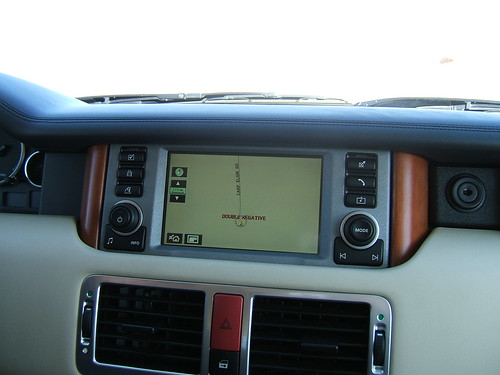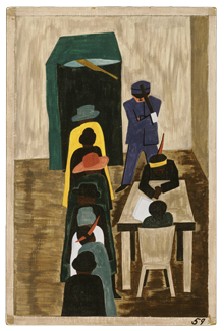
Last week, I took my 4-yo daughter to the Phillips Collection to see Jacob Lawrence’s masterpiece, The Migration of the Negro. It turned out to be the last day of the exhibition where the entire 60-panel series was on view. [MoMA owns the even-numbered paintings, the Phillips owns the odd-numbered ones.]
We’ve grown familiar seeing it all together this summer, but in the crowded gallery, as I read the caption on each panel and held the kid up so she could see, I couldn’t help but choke up when I got to the end, the culmination of The Great Migration, where millions of citizens fled the vestiges of the Civil War–poverty, discrimination, injustice, and violence–for an opportunity to work, go to school, raise their families–and to vote.
Author: greg
Finding Double Negative has never been easier
Not since we programmed it into the navigation system of my in-laws’ car, anyway.
The car also has an offroad navigation feature that logs virtual GPS breadcrumbs at preset intervals along the way, but it proved unnecessary. The nearly featureless mesa where Heizer’s land artwork is sited turns out to be a road with a name: Carp Elgin Rd.
In fact, there it is on Google Maps, one of the tightest satellite shots I’ve ever seen of Double Negative. Crazy.
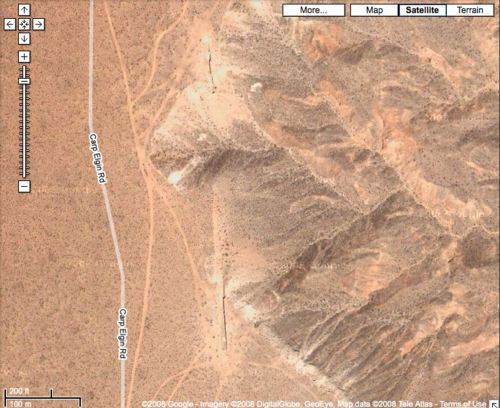
Update: OK, not to get all George Bush and the Grocery Scanner about it, but I just typed “Spiral Jetty” into Google Maps, and it came right up. With an upgraded photograph–and a label.
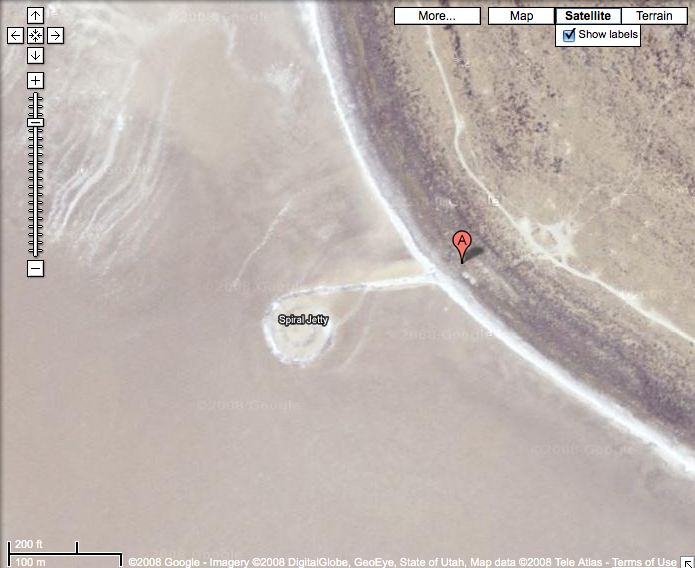
In fact, here are complete driving directions to the Jetty from 213 Park Avenue South, the former location of Max’s Kansas City. [note: there is a weird little, unnecessary jog at the very end that I couldn’t fix, but I’m not worried. Given the rate at which technology is iterating and altering the way once-isolated land artworks are experienced and perceived, I expect a realtime Google Streetview of the Jetty is already being planned on a whiteboard somewhere in Mountain View.]
Clearly, Google has been augmenting its map search with information found on the rest of the web. An otherwise seemingly Googleproof project like Michael Heizer’s City, which he sited as remotely as he could, is pinpointed by latitude and longitude coordinates published on a Land Art site. City also has newer photos.
Roden Crater’s there, under “Roden Crater, AZ,” but it still has the quaint, old-timey satellite photo from 2005 or whatever. I hope they’ll get around to upgrading it by the time Turrell finishes.
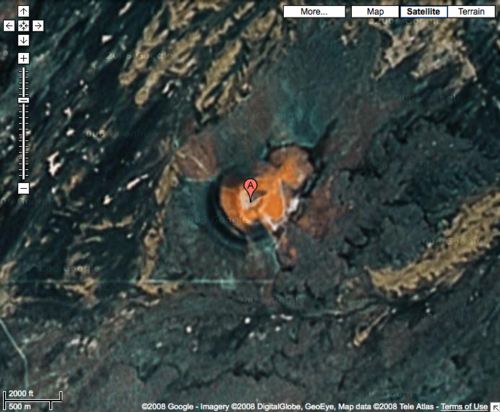
Satyajit Ray In Film India, c.1981
Steve Rosen found a 1981 interview with Indian filmmaker Satyajit Ray at the flea market. He transcribed a bit onto Airform Archive, starting with an encounter Ray had with the 1913 Nobel laureate Rabindranath Tagore:
Satyajit Ray: I’ll tell you a story here. In 1928, when I was seven, I went with my mother to Tagore’s university. I had my little autograph book, newly bought, and my mother gave the book to Tagore and said, “My son would like a few lines of verse from you.” And he said, “Leave the book with me.” Next day I went to collect it, and he brought it out and said: “I have written something for you, which you won’t understand now, but when you grow up you will understand it.” It’s one of the best things he ever wrote in a small manner, and what it means is this: “I have travelled all around the world to see the rivers and the mountains, and I’ve spent a lot of money. I have gone to great lengths, I have seen everything, but I have forgotten to see just outside of my house a dewdrop on a little blade of grass, a dewdrop which reflects in its convexity the whole universe around you.”
At first, I thought this sounded incredibly ballsy, but Tagore’s and Ray’s Brahmin families were close.
From the dewdrop, Ray and the interviewer continue in a discussion of the microscopic, but the power of the quote seems to me to be about ignoring the beauty and profundity of the world right in front of us.
Ray would go on to study with Tagore, and in 1961, Nehru commissioned him to direct a documentary of the writer’s life.
…the essence as a dewdrop on a little blade of grass… [airform archives]
Satyajit Ray [wikipedia]
I Shouldn’t Have Said Anything.
This morning I was buying a Diet Coke at the gas station, which forced the lady to get up from her chair by the radio.
“Arlo Guthrie! I didn’t even know he was still alive!”
“Really! You know who I’m always amazed to hear is still alive,” I said, trying to match both the tenacious age and the names’ quirkiness and rhythm as closely as possible: “Studs Terkel.”
Studs Terkel dies [chicagotribune]
Studs spoke at the Printers Row Book Fair in June [chicagopublicradio.org]
Drunk Floridians For Obama
Heh. My friends, this is drunk dialing we can believe in. [macdaddyworld via sullivan]
John On Jon: On Writing The Daily Show
How the hell did The Onion AV Club manage to score an interview with John Hodgman??
AVC: What is the process like on The Daily Show? How do ideas get developed and refined into a bit?
JH: I can only speak to my own experience, which is not unique but specific to the contributors, such as me and Larry Wilmore and Kristen Schaal. We’re not there every day. We come in twice a month and do our bits. The most common iteration is they provide me a topic and I’ll think about that topic for awhile and write up a first draft a couple days before. Then I’ll come in and work with David Javerbaum, the former Onion writer and now executive producer of the show, as well as Jon and some of the other executive producers of the show, to refine the idea. It will often change dramatically and we’ll often all write it from scratch together, basically to fit Jon’s vision of what he wants to do with the piece. And then we’ll go down and rehearse it that day, and then more often than not we’ll all get together in a room right after rehearsal, about an hour or two before the show, and rewrite it again, along with the rest of the show. Jon takes a very active role in shaping every word. We project the script on a wall and he goes through it line by line, makes adjustments, and makes every script sing as a result. It’s really kind of an astonishing process to watch. But for someone who had been primarily used to sitting in his underwear, working on a 2000-word magazine article for a month before anyone else ever read it, that seat-of-pants writing is very nerve-wracking. Very exciting, but I did want to vomit quite a bit.
Oh.
Interviews | John Hodgman [avclub]
I Love Paris In The Quarries
Spectacular. ITV took an underground tour of Paris with l’UX and the folks from Untergunther. They started in the sewer, went deeper into the quarries that provided the stones from which medieval Paris was built, and ended up–well, I’ll let you see yourself where they watched the sunrise from. [thanks for the tip, lazar!]
previous explorations of the explorateurs urbains of l’UX, Untergunther, and la Mexicaine de Perforation from greg.org
I’m Sorry, But This Headline Sounds Like It’s From The Onion
Housing Slump Begins to Hurt Classic Modernist Architecture [unbeige on a story in the la times]
Frankly, I thought the biggest threat to classic modernist architecture was the teardown-happy building boom.
That’s Not A Sforzian Background We Can Believe In

Just because you read the syllabus for Sforza 101 doesn’t mean you get credit for taking the course.
The secret of the human wallpaper backdrop is that it works best if you have either uniformed military or a racially diverse audience.

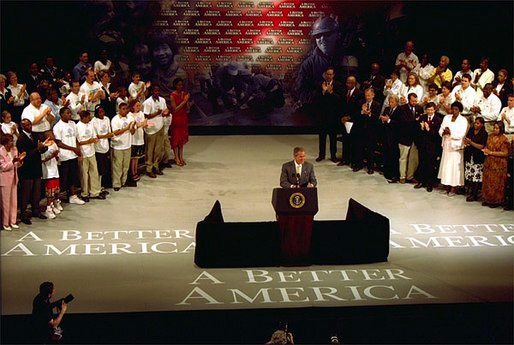
Guess those weren’t available.
[image: reuters/bryan snyder via salon]
Schoolhouse Rock The Vote
Awesome and funny. Or, I would like it to be funny on November 5th, anyway:
[via sullivan]
NO WAY: Did Sarah Palin Use Paris Hilton’s Stylist??
UPDATE: NO WAY, says Lisa Kline’s publicist. Check out the update at the bottom of the post.
UPDATE UPDATE: Now the NY Times has moved the Two Lisa Klines Theory ball down the field.
The payee for several of the fashion-related “campaign accessories” receipts included in this $150,000 Palin Shopping Spree is listed as Lisa L Kine of New York City. So far, I haven’t found any such person at the address given in the report.
But there is Lisa Kline, whose Google result reads, “Lisa Kline boutique clothing has hot designer jeans and dress shirts inspired by celebrity fashion style. High-end fashion in Beverly Hills…” Indeed, Lisa Kline boutique is on Robertson Blvd, the, Ground Zero [sic] of celebrity fashion.
Kline also just so happens to be the source of the leopard-print swimsuit Paris Hilton wore in her ad lampooning John McCain after he criticized Obama as a “celebrity.” Please, please let this be the same person.
NO WAY UPDATE:
I forwarded this Vimeo clip from Lisa Kline’s MySpace page to the owners of Pacifier, the Minneapolis baby store. They say they’re “pretty sure” that is the Republican Party operative who came in and purchased Trig Palin’s outfit a few hours before Sarah Palin’s speech at the GOP Convention.
[mini-doc] – Lisa Kline from [city of others] on Vimeo.
Let that sink in for a minute. I have a phoneathon for the kid’s preschool to attend.
UPDATE: Lisa Kline says NO WAY, she’s not Lisa Kline. Or at least Lisa Kline’s publicist says Lisa Kline isn’t Lisa Kline. I spoke with Lisa Kline of Beverly Hills’ publicist, who said that, while she wishes she could take the publicity, it’s not her Lisa Kline. In fact, her Lisa Kline has never even been to Minneapolis, and she couldn’t have dressed Sarah Palin because Lisa Kline boutique doesn’t sell suits. Also, if I wanted, she could suggest some great items from Lisa Kline’s baby store on Robertson for little Trig Palin for my story. So I guess that clears that up.
I also just spoke with Jon from Pacifier again, and he’s still pretty sure that the woman he sold Trig’s outfit to looks and sounds like Beverly Hills Lisa in her MySpace video. I guess we’ll wait for the real [sic] Lisa Kline to step forward and accept her accolades from the world’s media.
update update:: it’s not 100% yet, but the NY Times’ Caucus Blog makes a rather persuasive, data-based case that there are two Lisa Klines, one for Paris Hilton, and an entirely other one for Sarah Palin. They have different middle initials and everything.
Sarah Palin’s Shopping Spree Is So September 10th
OK, I started picking at Politico’s $150,000 Palin Family shopping spree on Daddy Types. There was an obviously inaccurate claim that the GOP had spent $295 on a sweet ride for Trig Palin at a baby store called Steiniauer & Stroller. Now I know you can’t get a sweet stroller or $300, so I was skeptical.
Turns out Steinlauer & Stoller is a sewing supply store in New York City. The RNC must use a receipt scanner to put together their monthly Schedule F form detailing all their expenses. [via josh green at the atlantic]
And this whole $4,900 for Todd Palin’s clothes at Atelier, “a high-class shopping destination for men”? Uh-uh.
Turns out the address of Atelier is not in Minneapolis, but “7th & 47th, New York.” There is nothing high-class about that neighborhood at. all. If Atelier were a store, it’s a crappy Going Out Of Business NOW! suit mill. I’m sure it’s not a coincidence, though, that Atelier Designers, a trade show of women’s fashion designers, was ensconced in seven floors of the Doubletree Inn–at the corner of 7th & 47th.
Some things don’t add up, though; Atelier ’09 was showing spring collections, not fall [aka campaign season]. And though the official dates for the show were Sept. 13-15, during Fashion Week, the RNC’s receipt has a date of 9/10/2008.
But Sept. 10th is also the date given for the big $75,000 Neiman Marcus spree in Minneapolis, which clearly outfitted the Palin clan for their appearance on stage Sept. 3rd.
And Sept. 10th is also the date given for the campaign’s $98 purchase at Pacifier, the Minneapolis baby store where I confirmed the RNC shopped on Sept. 3rd.
So more likely Sep. 10th was the day McCain campaign official Jeff Larson handed off his previous week’s receipts. Which still leaves a bit of mystery what “campaign accessories the RNC bought on Sept 3 at a trade show that wasn’t taking place for another two weeks. Perhaps some campaign staffer’s sister was debuting her collection of handpainted scarves and got a little help paying for her trade show booth?
McCains For Obama
No one can argue slavery had an upside, but this Wall Street Journal video is about as good as it gets.
Some Of McCain’s Black Relatives Support Obama [South Florida Times via wonkette]
“Possible” By Jonathan Hoefler For Artists For Obama
“For as long as I live, I will never forget that in no other country on earth is my story even possible.”
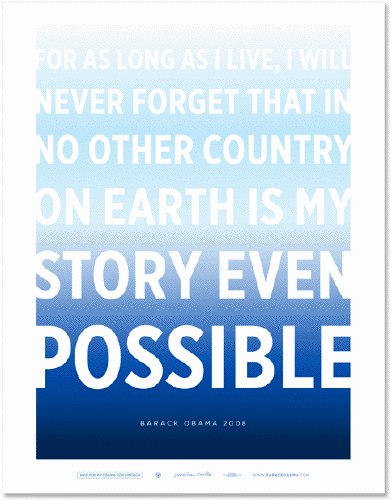
I just bought Jonathan Hoefler’s poster from the Barack Obama store. If you hurry, 4799 more of you can do the same.
“Possible” by type designer Jonathan Hoefler, $60 donation [store.barackobama.com via daringfireball]
Walter De Maria’s Las Vegas Piece
Here’s Walter De Maria describing his early land art work, Las Vegas Piece, to Paul Cummings in 1972. According to the Center For Land Use Interpretation, the piece is off Carp/Elgin Road in the Tula Desert, one exit north of Double Negative‘s Overton exit on I-15. The work is now “apparently” lost:
it takes you about 2 or 3 hours to drive out to the valley and there is nothing in this valley except a cattle corral somewhere in the back of the valley. Then it takes you 20 minutes to walk off the road to get to the sculpture, so some people have missed it, have lost it. Then, when you hit this sculpture which is a mile long line cut with a bulldozer, at that point you have a choice of walking either east or west. If you walk east you hit a dead end; if you walk west you hit another road, at another point, you hit another line and you actually have a choice. At that point you decide which way to go and so forth, then you continue, you walk another mile and at another point you walk another half mile so and at a certain point you have to double back. After spending about four hours, you have walked through all of the three miles of the thing and you would have gotten your orientation because the sun will also be setting in the west and this is lined up so that all the lines are either east-west or north-south. Now I did this piece in 1969 and I haven’t done an article on it because I didn’t find a way to photograph it properly. You can only photograph in multiple views, you know, like this is looking east and this is looking . . . .
PC: A satellite shot.
WDM: Well, that’s true, but that’s a different experience because that’s an experience like a drawing but this is an experience at ground level, it’s a different experience.
PC: How wide are the lines?
WDM: Ten feet wide, eight or ten feet wide.
PC: And they are how deep?
WDM: Oh, it’s about a foot deep, two feet deep and about eight feet wide. The point I’m making here is that the most beautiful thing is to experience a work of art over a period of time. For instance, architecture we know has always thought about this. You go into the palace, you go into the house, you experience the different floors, you sit in certain rooms for certain amounts of time and when, after an hour or half hour or four or five hours you walk out again. You’ve experienced all of the proportion and relationships; you’ve experienced something over a period of time. Well, most sculptures have always been confined to being a single object, no mater what the style of configuration — expressionist or figurative, whatever.
PC: You look at it from this point and that point.
WDM: You look at it and maybe walk around it and, basically, let’s face it. How much time does a person spend with a piece of sculpture? An average of perhaps less than one minute, maximum of five or ten, tops. Nobody spends ten minutes looking at one piece of sculpture. So by starting to work with land sculpture in 1968 I was able to make things of scale completely unknown to this time, and able to occupy people with a single work for periods of up to an entire day. A period could even be longer but in this case if it takes you two hours to go out to the piece and if you take four hours to see the piece and it takes you two hours to go back, you have to spend eight hours with this piece, at least four hours with it immediately, although to some extent the entrance and the exit is part of the experience of the piece. So what happened, though, which was very interesting in connection with the idea of theatre or film is that to build one of these pieces becomes a major logistical economic undertaking. Like if a person wants to make a movie, we all now that it takes sixty or eighty thousand dollars to make a feature film of any kind, black and white, not too much original music and not too many name stars, and it takes four or five hundred thousand dollars to make any medium size picture and a million to two million dollars to make any decent type of major film. Well, the notion that maybe a piece of sculpture might take an investment of forty or fifty thousand dollars and . . . but when it’s finished, it gives the person an experience with could take him several ours or several days to experience is something I’ve been fighting now for the last four years, starting now the fifth year.
The comparisons to architecture and cinema are both eye-opening. Minimalists like Judd and Flavin spoke of sculpture as space, but De Maria’s talking about sculpture as time. Which is worth remembering when you sign up for a 24-hour stay at the Lightning Field.

